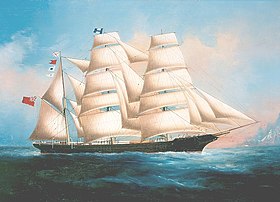
Back سفينة شراعية Arabic Ветроходен кораб Bulgarian Bageerezh-dre-lien Breton Jedrenjak BS Veler Catalan کەشتیی چارۆکەدار CKB Plachetnice Czech Парăслă карап CV Llong hwylio Welsh Sejlskib Danish

A sailing ship is a sea-going vessel that uses sails mounted on masts to harness the power of wind and propel the vessel. There is a variety of sail plans that propel sailing ships, employing square-rigged or fore-and-aft sails. Some ships carry square sails on each mast—the brig and full-rigged ship, said to be "ship-rigged" when there are three or more masts.[1] Others carry only fore-and-aft sails on each mast, for instance some schooners. Still others employ a combination of square and fore-and-aft sails, including the barque, barquentine, and brigantine.[2]
Early sailing ships were used for river and coastal waters in Ancient Egypt and the Mediterranean. The Austronesian peoples developed maritime technologies that included the fore-and-aft crab-claw sail and with catamaran and outrigger hull configurations, which enabled the Austronesian expansion into the islands of the Indo-Pacific. This expansion originated in Taiwan c. 3000 BC and propagated through Island Southeast Asia, reaching Near Oceania c. 1500 BC, Hawaii c. 900 AD, and New Zealand c. 1200 AD.[3] The maritime trading network in the Indo-Pacific dates from at least 1500 BC.[4][failed verification] Later developments in Asia produced the junk and dhow—vessels that incorporated features unknown in Europe at the time.
European sailing ships with predominantly square rigs became prevalent during the Age of Discovery (15th to 17th centuries), when they crossed oceans between continents and around the world. In the European Age of Sail, a full-rigged ship was one with a bowsprit and three masts, each of which consists of a lower, top, and topgallant mast.[5] Most sailing ships were merchantmen, but the Age of Sail also saw the development of large fleets of well-armed warships. The many steps of technological development of steamships during the 19th century provided slowly increasing competition for sailing ships — initially only on short routes where high prices could be charged. By the 1880s, ships with triple-expansion steam engines had the fuel efficiency to compete with sail on all major routes — and with scheduled sailings that were not affected by the wind direction. However, commercial sailing vessels could still be found working into the 20th century, although in reducing numbers and only in certain trades.
- ^ Quiller-Couch, Arthur Thomas (1895). The Story of the Sea. Vol. 1. Cassell and Company. p. 760. Archived from the original on 2023-10-27. Retrieved 2017-07-25.
- ^ Parker, Dana T. Square Riggers in the United States and Canada, pp. 6–7, Transportation Trails, Polo, IL, 1994. ISBN 0-933449-19-4.
- ^ Atholl Anderson (2018). Cochrane, Ethan E; Hunt, Terry L. (eds.). The Oxford Handbook of Prehistoric Oceania. New York: Oxford University Press. ISBN 978-0-19-992507-0.
Yet, no other major topic in Oceanic prehistory has proven so intractable, for almost no remains of offshore boats have been described and seafaring left neither a pre-European record of the structure and rigging of boats, except enigmatically in rock art, nor more than a faint ethnographic trace of the basic techniques of long-distance sailing, navigation, and seakeeping. That Oceanic seafaring can be discussed at all depends largely, and tenuously, upon its construction by proxy.
- ^ Bellina, Bérénice (2014). "Southeast Asia and the Early Maritime Silk Road". In Guy, John (ed.). Lost Kingdoms of Early Southeast Asia: Hindu-Buddhist Sculpture 5th to 8th century. Yale University Press. pp. 22–25. ISBN 9781588395245.
- ^ "ship". Oxford English Dictionary (Online ed.). Oxford University Press. (Subscription or participating institution membership required.)
© MMXXIII Rich X Search. We shall prevail. All rights reserved. Rich X Search



